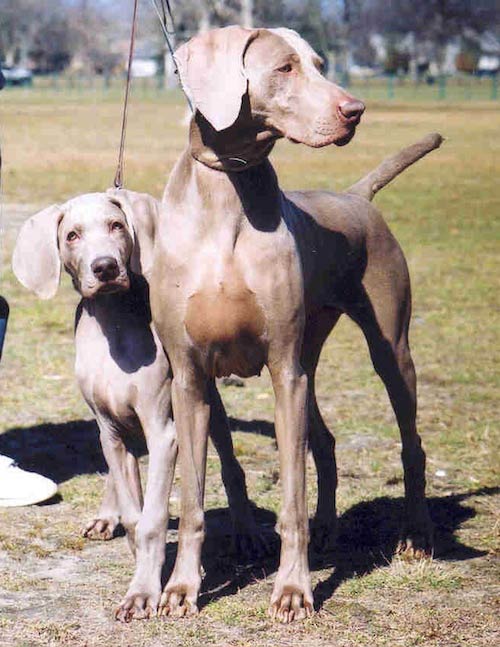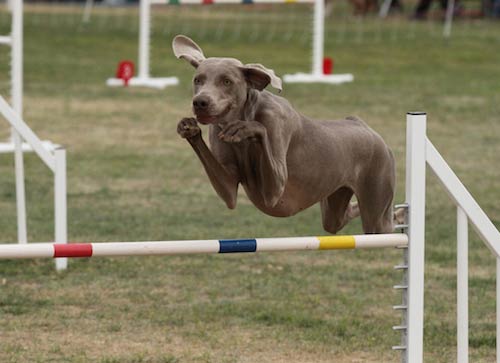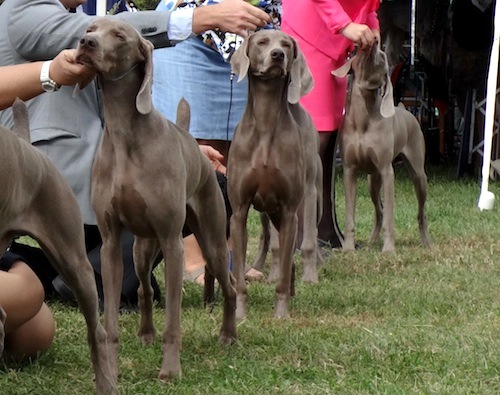Carole Lee Richards got her first Weimaraner in 1978. She was just looking for a pet at the time, but her interest in the breed quickly grew, and eventually she bred her first litter and was competing in dog shows. Since then she has bred many champions, become an AKC judge, and handled Weimaraners in field, agility, and obedience events as well as dog shows.
Carole shares information and insights about Weimaraners in the AKC Gazette magazine four times a year as columnist for the breed’s national parent club, the Weimaraner Club of America. Following are a few insights and anecdotes from this longtime expert in the breed.

Weimaraner dam and puppy (courtesy Carole Lee Richards)
1. Weimaraners are high energy.
Weimaraners can be dynamos. If the breed’s energy is channeled, it is an asset. It’s a good thing if you’re doing fieldwork, pursuing an agility title, or enjoy an active, outdoor lifestyle. They are strong animals with the stamina and desire to work and play for long stretches of time. They need an outlet for all their energy, and they prefer exercise they can do with you.

2. Weimaraners don’t like to be left alone.
Dealing with separation anxiety is something that new owners need to be educated about. While it may take some work to accustom a Weimaraner to the fact that they can’t be with you 24/7, it’s a training issue and one that can be accomplished.
The characteristic of wanting to be with you is an ultimate expression of the bond between man and Weimaraner. Some say that getting a Weimaraner is like getting a second shadow. Yup, I can’t argue with that—and it is a characteristic that I personally treasure about the breed.

3. Weimaraners love to chew (and sometimes swallow) lots of things. Non-food things.
Why do they have to chew on everything? The Weimaraner’s chewing menu is extensive and includes the most dreaded of items: rocks. Chewing rocks destroys their beautiful, white teeth—and worse yet, when rocks are swallowed they can be lethal. I’ve known many an owner who has had to take their dog in for surgeries to remove rocks.
I’ve talked about this problem with a number of frustrated owners of rock-eaters, and only two viable solutions have emerged. The first tactic is to prevent contact with rocks. To do this, owners can make an investment in a muzzle—the type that is like a cage or basket over and around the dog’s nose and mouth.
Unfortunately, basket muzzles have drawbacks. First, there’s the constant on-and-off of the muzzle—an exercise akin to bundling kids into snowsuits. The moment you get it on, they want it off. And then there’s the learned behavior of using the basket muzzle as a battering ram. Once this behavior is learned you should consider your Weimaraner “armed and dangerous.” They’ll bull their way through, using the newfound protection of their basket muzzle to clear the way. People, other dogs, and outdoor furniture will bear the brunt of your muzzle-wielding Weimaraner.
The second solution is one that I’ve successfully used with generations of my dogs. I start them out as puppies. When they have something in their mouth, I encourage them to bring it to me, and I’ll “buy” it from them. Initially I’ll barter with a food reward, and quickly they find more value in food than chomping on a yucky rock. We trade the rock for a snack, and it becomes a game.
What’s the drawback to this one? You’ll have little collections of rocks and pebbles deposited at your feet or waiting for you on your porch. I’ve gone out my back door and found little heaps of rocks, some of them still warm from being carried around.
Come to think of it, it’s not much of a drawback, and it beats having emergency surgery, and maybe I can start that rock garden that I’ve always wanted.

4. Handling a young Weimaraner at a dog show for the first time can be an adventure.
Years ago, I entered a puppy from my first litter at a local dog show. The sport of purebred dogs was a new and exciting activity for which neither my puppy nor I were totally prepared. We both arrived wide-eyed; she was wiggling with delight, and I was quaking at the prospect of entering the show ring.
Heeding the advice of those with more experience, I had picked a show with a judge who was known to love having puppies in his ring. My apprehension went into full-blown, head-over-heels panic when I saw a posted sign that there was a last-minute judge change. Our new judge was none other than Mrs. Anne Rogers Clark.
I may have been “green” to the sport, but I knew enough to realize I was about to show to a person of great stature. First, there was physical stature—she stood six feet tall—but secondly, Mrs. Clark was one of the premier judges in all of dog showing. “Premier”? More than that; her reputation was absolutely lofty. And there I stood with my almost-out-of-control puppy, about to enter her ring.
The butterflies that had only been in my stomach now permeated my entire body. I was a nervous wreck, weak in the knees, and praying for a merciful deliverance that never came.
The puppy class of one was called, and we entered the ring. I couldn’t even look at the judge but rather busily attempted to stack my puppy.
A commanding, authoritative voice came from far above.
“Don’t set up—take her around.”
I wobbled on knees that had turned to jelly, and my puppy moved around the ring like she was supposed to. So far, so good, but then I needed to have her stand and keep still for examination. It was a total disaster. The more I tried, the more the puppy thrashed. I found myself reciting the mantra “Stay… stay … stay.”
Then in that same serious, authoritative voice, I heard Mrs. Clark say, “To tell a Weimaraner puppy to stand still is like telling a waterfall not to flow.”
Now, if this were a corny Hollywood movie script, my puppy would have gone on to win it all. However, in reality she won her class of one, collected no other ribbons, and had a positive show experience. We had a judge who immediately recognized the limitations of the animal and the exhibitor and did nothing that was negative. There was no wrestling to get the puppy to stand still, no lecturing of the novice handler. We went away, single ribbon in hand, determined to try it again.

5. People will mangle the pronunciation of “Weimaraner”—but there’s something you can do about it.
My telephone rings a lot, and since I work with breeder referral for my local Weimaraner club, the call is frequently from a person looking for a puppy.
While I enjoy helping people get in touch with reputable breeders, there’s one little thing about the job that just drives me crazy. It’s something that should just be a minor annoyance, a tiny blip, a “no big deal,” but for me it’s the fingernail slowly screeching across the blackboard …
I answer the phone, and a pleasant-enough voice makes an introduction and explains how they got my phone number. I know it’s coming, and I brace myself for the assault. “I’m looking for a puppy, and I’ve always wanted a Weimerangger.” Or sometimes it’s a “Weimeringer,” a “Weimmer,” a “Weimeran,” or some such mangled pronunciation of Weimaraner. Occasionally they don’t even try to say the word and attempt to talk around it but then, with a tone of embarrassment and frustration, confess that they can’t say it.

Here’s an easy solution, one that’s so simple that people are simultaneously amused and educated in the blink of an eye:
First, tell the person you’re going to teach them a trick to saying “Weimaraner.” Put them at ease by asking them to say the word “honor,” because that’s the hardest part of saying the word. Ask them to say “y” and “mar”—then have them unscramble all that into y-mar-honor.
You won’t believe the look of “Is that really all there is to it?” You’ll know you’ve totally succeeded when they successfully pronounce “Weimaraner” in the ensuing conversation. Most folks will give their shiny new word a try and succeed.
OK, by doing this we’re not finding the cure for the common cold or achieving world peace, but it’s a tiny step to improving our breed’s image and stamping out a really annoying pronunciation blunder.
My “y-mar-honors” and I wish you good luck in this quest.
The Weimaraner is not a breed for everyone … in fact, there’s no breed that fits the universal needs of all dog owners. Educating prospective first-time owners about the Weimaraner is a mix of warning about the negatives and praising the positive things that make our breed unique. —C.L.R.
Carole Lee Richards is an AKC judge and co-author of Raising a Champion: A Beginner’s Guide to Showing Dogs. She writes the Weimaraner breed column that appears in the January, April, July, and October issues of the AKC Gazette.
Wondering if the Weimaraner might be the right breed for you? Find more information on the breed pages, and visit the website of the breed’s national parent club, the Weimaraner Club of America.


